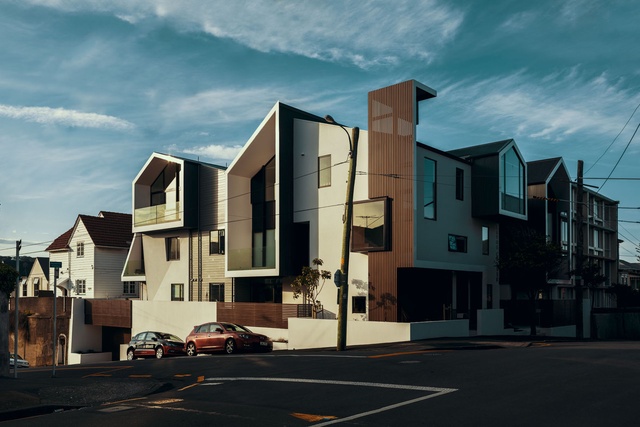Opinion: Force de frappe
Pip Cheshire finds himself in a bit of a dilemma when it comes to government directives on housing density: the nimby versus the urbanist versus the politico.

I’m sitting in the sun on our verandah in a gentle, warm, reflective moment: a rare and welcome respite from rain and work as I consider the awful good fortune of being here. We were the beginning of the bourgeois rot: an insidious displacement of Samoan, Tongan, Niuean and the occasional palagi student occupants, forced to move away from crowded villas and the front-room churches with their Baptist-style exhortations and booming hymns.
On that gentle sunny morning, I mused over the government’s pronouncement that those of us within walking distance of the city should be prepared to start packing, loading our handcarts with our widescreen TVs and designer furniture for our own shlep out of the neighbourhood, the picturesque little villas on either side cleared away to make an apartment block site. Perhaps the villas will be trucked out to the lifestyle blocks of the west, there to sit lonely, their fretwork speaking an unknown urban/pedestrian dialect in ute town. And, in their place, where we tended our lemon trees, avocados and vegetable plots, the new city apartments will be rising up, shading those last few hold-outs sitting on their verandahs.
It all makes some sort of sense; I have touted the attraction of our little enclave as being its proximity to the city in front and the bars of Ponsonby behind, that one might stride into university in the morning and later crawl home from the bars up the road. So, now, is there to be another evolution, like the urban renewal of the 1960s when the motorway was pushed through the valley and the rolling, corrugated-iron foothills below us cleared away for Council housing, driven along by the walk-to-work enthusiasms of the planners? Or will, this time, the planners have met their match with rights-wise Canutes facing back the advancing phalanx of our tribe: the surveyors with their pesky little drones and GPS wands, then we architects, squinting and sketching and CADing ahead of the motorised column, the diggers, the pumps, the cranes and the tradies.
And what of me? Where do I sit? Does the imperative of planetary survival trump closet nimbyism and appeals to the cultural importance of preserving the picturesque artefacts of economic imperialism? It seems far-fetched that it should come to this, that a government dictate to facilitate development might prevail over, in this case, the twin bogeys of the hitherto deeply enshrined belief in the unrestrained workings of the property market and the City’s belief in the importance of heritage zones and white cultural continuity.
I have often been a bit sniffy about the doctrinaire way that planners operate: that, in the tough grind up between social idealism and the relentless assaults of those hoping to turn a square metre of northern slope into the deposit on a Range Rover, they are forced into the witless recitation of clauses and subsections, knowing that every decision is just a barrister’s arched eyebrow away from the courts. I have seen this machine in operation, been privy to it, indeed an active player: at times, a foot soldier attempting to prise apart the subsections and gain a client’s advantage, pushing and arguing without tipping into the abyss of a contested hearing. At times, too, I have argued as a panellist on the Urban Design Panel (UDP), in favour of the inner-city skyline being something more than the vertical transposition of the underlying topography.
Sometimes, at the panel, we have had a robust discussion on the desirability of manipulating the rooftop, adding a bit here at the expense of some over there, gaining a little more of that valuable gross floor area if the result is some sculptural modelling. Sometimes, we have left the arena of the panel with some hope that, even if we may not end up with the delights of the Manhattan robber barons’ towers, there has been a clear indication of the panel’s desire to support some give-and-take as the details of height and bulk are resolved in final consent design. I am sorry to say that when one observes the final result, often so many months later, one is uncertain whether or not we had anything to do with it at all. The articulations of the ‘fifth elevation’ are nowhere apparent and one assumes that, between the soft opening offered by the UDP’s recommendations and the hard ball of a final consent application, the subsection’s text has prevailed as the compromise yet again, the planners having to negotiate the applicants’ inch play with gains taken and losses endlessly relitigated.
I am clearly a minnow when push comes to shove in shaping the city and so, I suspect, are many others of our tribe. If proof were needed, the government’s cajoling of local authorities to facilitate, neigh insist on, the intensive development of those bits of their bailiwicks within crawling distance of the CBD and public transit suggests a new era of planning by fiat, acting with all the subtlety of a bureaucratic force de frappe.
Frankly, as with most things these days, I find myself in a bit of a dilemma: the nimby in me shrieks “over my dead avocado tree will you trash the house”; the urbanist sees the wisdom of concentrated infrastructure-centred housing and sneers at mawkish heritage sentimentalism; while the would-be politico admires a bit of direct action and evidence that, at last, someone in government understands that housing supply is too complicated for the market to resolve, no matter how much it’s chopped and channelled by some Treasury wunderkind. I have an uncomfortable feeling that, despite the best intentions of an army of well-intentioned souls in City Hall, democracy, or mobocracy as Frank Lloyd Wright called it, might not be up to it and a little autocracy might be called for. Certainly, we need to stop the commodification of our housing stock and begin to understand it as national infrastructure, as critical to our sense of common wealth and well-being as a hydro dam or a port.
The feeling that we might need a good dose of direct action from HQ to address some of the more intractable matters of the day is an uncomfortable realisation for one with pride in having taken to the streets a few times to recalibrate the actions of an out-of-touch government. Direct action by government fiat of course requires that those exercising it have the right skills for the issues. Looking at a few of our local quagmires, the current parlous state of Auckland’s CBD, for example, suggests that those tucked up in City Hall feel no need of design input when making decisions; indeed, the demise of the Auckland Design Office and the loss of its garrulous spokesperson might be mistaken for an assault on knowledge.
Lest one thinks HQ’s intervention alone will sort things out, I urge you to recall the wilful ignorance of the flag debate and the disdain with which designers of any ilk were treated. It’s a different mob now, one more predisposed to engaging in the tricky issues of social justice but, for all that, I fear the Wellington behemoth’s entry into urban planning does not augur well for balancing action, knowledge and experience. Once again, one feels the problem with autocracy in this country is that, damn it, we architects and our designer mates are excluded from it.
Letter to the Editor
Architecture NZ
I would like to thank Pip Cheshire and your publishing of his excellent article on the architectural responses to the accelerating imperative of increasing built density vs heritage preservation.
I believe that the situation actually presents a great opportunity for us architects to reclaim our current marginalisation by using our creativity and imagination.
Malcolm Walker’s cartoon at the back of the same magazine perfectly illustrates that at the end of the day, architects are generally considered responsible anyway.
The greater public associate architects with beautiful buildings and our recent reputation has been compromised by constricting planning rules and pedantic urban design leading to an embarrassing level of built mediocrity.
We needn’t think that intensification and the retention of character are mutually exclusive. In fact they can enrichen the built environment. We should seize this opportunity.
I offer two recent(ish) examples to illustrate approaches to denser land use.
The first is the listed cottage that is home to the yummy Boulcott St. Brassserie, in the CBD, was moved forward on its site to allow a sympathetic development behind.
The second is a new build, the Zavos Corner development in Mt.Victoria that preserves and extends the character of its surroundings.
Roger Walker
WELLINGTON











